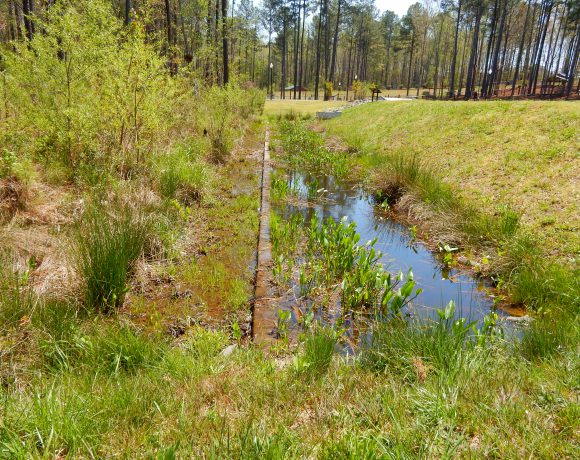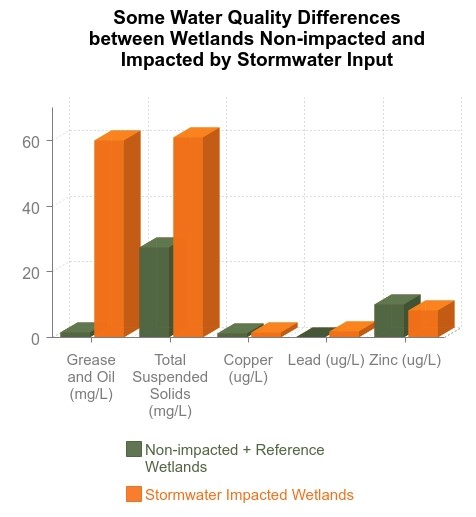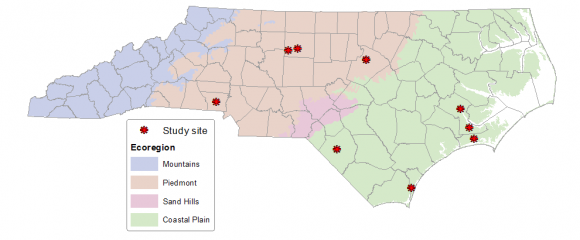
A level spreader slows down stormwater before it enters a wetland.
Project Summary
The use of natural wetlands for stormwater treatment can be a beneficial practice, especially where existing site conditions are prohibitive or sufficient portions of land are not available for treatment facilities or devices. In some cases, pre-existing natural wetlands have been filled to make room for stormwater detention ponds. Development can also alter ground and surface water patterns, causing natural wetlands to dry out. Discharging stormwater into these wetlands may maintain the wetland’s natural hydrology. Because natural and man-made wetlands have been shown to be effective tools for filtering and trapping pollutants, our researchers sought to study whether stormwater assimilation in natural wetlands is preferable to replacement with man-made detention ponds.
Despite advantages of using natural systems for stormwater treatment, negative consequences are possible. Pollutant loading levels associated with stormwater may exceed a wetland’s capacity to assimilate those pollutants and thereby cause detrimental effects, such as plant mortality, alteration of plant diversity, changes in animal species composition, toxicity to animals, etc.
NC Division of Water Resources scientists conducted a four-year research project assessing the impact of residential and commercial stormwater discharge on wetlands across the Piedmont and Coastal Plain ecoregions of North Carolina. Ten wetland sites representing a variety of different hydrogeomorphic and vegetation types were selected for this study. Three wetland sites were receiving stormwater runoff at the time of the study, four sites had yet to receive runoff which was planned, two sites were natural reference sites, and one site began receiving runoff during the study (pre- and post- data were obtained). Runoff was primarily residential in nature, except for one site being developed for commercial/office land use during the study. Capacity to assimilate pollutants, water chemistry, water depth, soils, sedimentation, vegetation, aquatic invertebrate species, and amphibian species data were gathered to assess negative impacts to wetlands and their ability to retain and treat stormwater.

Results
- Water collected from stormwater-impacted wetlands showed much higher levels of pollutants than sites that did not receive stormwater. Concentrations of the following pollutants were twice as high or more in the impacted wetlands: suspended solids, oil and grease, total nitrogen, total phosphorus, aluminum, and lead.
- Assessing changes in pollutant level between inlet and outlet in three individual wetlands emphasized the fact that each wetland is unique, with multiple variables influencing outcomes. No generalities were possible from the data, because changes in pollutant levels from inlet to outlet varied by site and pollutant, sometimes decreasing, even drastically so, but sometimes increasing.
- Amphibian surveys indicated frogs present at all but one site, including wetlands receiving stormwater. Long term viability of these populations may be reduced by stormwater pollutants.
- Invasion by exotic or aggressive plant species was one of the most obvious biological impacts of stormwater flows into wetlands observed in the study.
 Researchers concluded that under certain circumstances, stormwater discharge to natural wetlands is feasible and can provide two main benefits, hydrologic restoration of disturbed wetlands and reduction of some stormwater pollutants. Despite these benefits, negative consequences were also observed. Channelization, sedimentation, and a shift to larger soil particle size were noted in several wetlands receiving stormwater discharge. Creating diffuse flow could lessen these impacts. Observed effects of stormwater discharge on wetland biota were minimal, though there was some evidence of flood-induced tree mortality. However, many potential impacts of stormwater discharge to natural wetlands are gradual in nature and the limited time frame of this study did not allow for thorough examination of more long-term consequences of this practice.
Researchers concluded that under certain circumstances, stormwater discharge to natural wetlands is feasible and can provide two main benefits, hydrologic restoration of disturbed wetlands and reduction of some stormwater pollutants. Despite these benefits, negative consequences were also observed. Channelization, sedimentation, and a shift to larger soil particle size were noted in several wetlands receiving stormwater discharge. Creating diffuse flow could lessen these impacts. Observed effects of stormwater discharge on wetland biota were minimal, though there was some evidence of flood-induced tree mortality. However, many potential impacts of stormwater discharge to natural wetlands are gradual in nature and the limited time frame of this study did not allow for thorough examination of more long-term consequences of this practice.
Though stormwater discharge into natural wetlands in lieu of discharging directly to streams can help promote water quality in downstream waters, precautions are necessary to minimize negative impacts to wetlands associated with this practice. Pretreatment of stormwater and promotion of diffuse flow are necessary to reduce wetland impacts and to maximize stormwater assimilation. Proper site selection and appropriate sizes of wetlands to be utilized for stormwater assimilation can minimize impacts to high quality wetlands and ensure adequate treatment of stormwater.
The final report emphasizes techniques that can promote the benefits of using natural wetlands for assimilation of stormwater while minimizing detriment to natural systems. Based on the observations made in this study and a review of relevant literature, guidelines are provided that should be applied to stormwater discharge to wetlands to achieve these ends.
Take home points and recommendations:
- Pre-treatment of stormwater before discharge to natural wetlands is important. Pre-treatment through created detention wetlands, dry detention basins, or grass swales can reduce impacts associated with sediment deposition and erosion.
- Appropriate size of receiving wetlands is critical. Wetlands that are too small to retain runoff from a typical precipitation event will fail to properly treat stormwater and may experience negative effects from flooding. Diversion of excess stormwater flows can be an effective means to protect wetlands from flooding impacts.
- Promotion of diffuse flow of stormwater into a wetland can reduce the velocity of stormwater and provide for extended stormwater retention.
- Dense vegetation is useful in extending residence time by reducing velocity of discharge through wetlands.
- Deep organic soils are favorable for treatment of stormwater because of their capacity to retain water and adsorb nutrients, metals, and other contaminants.
- Disturbed wetland sites should be preferentially selected for stormwater discharge. Rare wetland types, wetlands of pristine natural quality, and sites harboring rare, threatened, or endangered species should be protected from stormwater discharges.
- Before discharges to natural wetlands occur, baseline biological data should be collected to determine the presence of any rare, vulnerable, or environmentally sensitive species.

